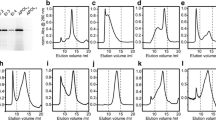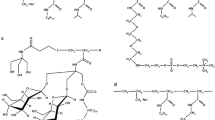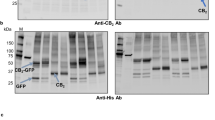Abstract
G protein-coupled receptors are at a central node of all cell communications. Investigating their molecular functioning is therefore crucial for both academic purposes and drug design. However, getting the receptors as isolated, stable and purified proteins for such studies still stumbles over their instability out of the membrane environment. Different membrane-mimicking environments have been developed so far to increase the stability of purified receptors. Among them are amphipols. These polymers not only preserve the native fold of receptors purified from membrane fractions but they also allow specific applications such as folding receptors purified from inclusion bodies back to their native state. Of importance, amphipol-trapped G protein-coupled receptors essentially maintain their pharmacological properties so that they are perfectly adapted to further investigate the molecular mechanisms underlying signaling processes. We review here how amphipols have been used to refold and stabilize detergent-solubilized purified receptors and what are the main subsequent molecular pharmacology analyses that were performed using this strategy.



Similar content being viewed by others
Abbreviations
- 5HT4(a):
-
5-Hydroxytryptamine receptor 4
- 12-HHT:
-
12S-Hydroxyheptadeca-5Z, 8E,10E-trienoic acid
- A8-35:
-
Polyacrylate-based amphipol A8-35
- AVP:
-
Arginine-vasopressin
- BLT1:
-
Leukotriene B4 receptor 1
- BLT2:
-
Leukotriene B4 receptor 2
- CB1:
-
Cannabinoid receptor 1
- CRINEPT:
-
Cross-correlated relaxation-enhanced polarization transfer
- CXCR1:
-
C-X-C chemokine receptor 1
- DDM:
-
Dodecyl-β-D-maltopyranoside
- FRET:
-
Fluorescence resonance energy transfer
- FomA:
-
Outer membrane protein A from Fusobacterium nucleatum
- GHS-R1a:
-
Ghrelin receptor type 1
- GPCR:
-
G protein-coupled receptor
- IB:
-
Inclusion bodies
- LRET:
-
Luminescence resonance energy transfer
- LTB4 :
-
Leukotriene B4
- MNG:
-
Maltose-neopentylglucose
- OmpA:
-
Outer membrane protein A from Escherichia coli
- NaPol:
-
Non-ionic amphipol
- NMR:
-
Nuclear magnetic resonance
- Sf9 :
-
Spodoptera frugiperda
- V2R:
-
Vasopressin receptor 2
References
Andrell J, Tate CG (2013) Overexpression of membrane proteins in mammalian cells for structural studies. Mol Membr Biol 30(1):52–63
Arcemisbehere L, Sen T, Boudier L, Balestre MN, Gaibelet G, Detouillon E, Orcel H, Mendre C, Rahmeh R, Granier S, Vives C, Fieschi F, Damian M, Durroux T, Baneres JL, Mouillac B (2010) Leukotriene BLT2 receptor monomers activate the G(i2) GTP-binding protein more efficiently than dimers. J Biol Chem 285(9):6337–6347
Baneres JL, Popot JL, Mouillac B (2011) New advances in production and functional folding of G-protein-coupled receptors. Trends Biotechnol 29(7):314–322
Bazzacco P, Billon-Denis E, Sharma KS, Catoire LJ, Mary S, Le Bon C, Point E, Baneres JL, Durand G, Zito F, Pucci B, Popot JL (2012) Nonionic homopolymeric amphipols: application to membrane protein folding, cell-free synthesis, and solution nuclear magnetic resonance. Biochemistry 51(7):1416–1430
Catoire LJ, Damian M, Giusti F, Martin A, van Heijenoort C, Popot JL, Guittet E, Baneres JL (2010) Structure of a GPCR ligand in its receptor-bound state: leukotriene B4 adopts a highly constrained conformation when associated to human BLT2. J Am Chem Soc 132(26):9049–9057
Catoire LJ, Damian M, Baaden M, Guittet E, Baneres JL (2011) Electrostatically-driven fast association and perdeuteration allow detection of transferred cross-relaxation for G protein-coupled receptor ligands with equilibrium dissociation constants in the high-to-low nanomolar range. J Biomol NMR 50(3):191–195
Dahmane T, Damian M, Mary S, Popot JL, Baneres JL (2009) Amphipol-assisted in vitro folding of G protein-coupled receptors. Biochemistry 48(27):6516–6521
Dahmane T, Rappaport F, Popot JL (2013) Amphipol-assisted folding of bacteriorhodopsin in the presence or absence of lipids: functional consequences. Eur Biophys J 42(2–3):85–101
Damian M, Martin A, Mesnier D, Pin JP, Baneres JL (2006) Asymmetric conformational changes in a GPCR dimer controlled by G-proteins. EMBO J 25(24):5693–5702
Damian M, Marie J, Leyris JP, Fehrentz JA, Verdie P, Martinez J, Baneres JL, Mary S (2012) High constitutive activity is an intrinsic feature of ghrelin receptor protein: a study with a functional monomeric GHS-R1a receptor reconstituted in lipid discs. J Biol Chem 287(6):3630–3641
Della Pia EA, Holm JV, Lloret N, Le Bon C, Popot JL, Zoonens M, Nygard J, Martinez KL (2014) A step closer to membrane protein multiplexed nanoarrays using biotin-doped polypyrrole. ACS Nano 8(2):1844–1853
Deupi X, Standfuss J, Schertler G (2012) Conserved activation pathways in G-protein-coupled receptors. Biochem Soc Trans 40(2):383–388
Giusti F, Rieger J, Catoire LJ, Qian S, Calabrese AN, Watkinson TG, Casiraghi M, Radford SE, Ashcroft AE, Popot JL (2014) Synthesis, characterization and applications of a perdeuterated amphipol. J Membr Biol 36(7):1–6
Inagaki S, Ghirlando R, White JF, Gvozdenovic-Jeremic J, Northup JK, Grisshammer R (2012) Modulation of the interaction between neurotensin receptor NTS1 and Gq protein by lipid. J Mol Biol 417(1–2):95–111
Irannejad R, Tomshine JC, Tomshine JR, Chevalier M, Mahoney JP, Steyaert J, Rasmussen SG, Sunahara RK, El-Samad H, Huang B, von Zastrow M (2013) Conformational biosensors reveal GPCR signalling from endosomes. Nature 495(7442):534–538
Kaya AI, Thaker TM, Preininger AM, Iverson TM, Hamm HE (2011) Coupling efficiency of rhodopsin and transducin in bicelles. Biochemistry 50(15):3193–3203
Kenakin T (2011) Functional selectivity and biased receptor signaling. J Pharmacol Exp Therap 336(2):296–302
Lagerstrom MC, Schioth HB (2008) Structural diversity of G protein-coupled receptors and significance for drug discovery. Nat Rev Drug Discovery 7(4):339–357
Lang S, Spratt DE, Guillemette JG, Palmer M (2005) Dual-targeted labeling of proteins using cysteine and selenomethionine residues. Anal Biochem 342(2):271–279
Le Bon C, Popot JL, Giusti F (2014) Labeling and functionalizing amphipols for biological applications. J Memb Biol 288(37):26419–26429
Luttrell LM, Kenakin TP (2011) Refining efficacy: allosterism and bias in G protein-coupled receptor signaling. Methods Mol Biol 756:3–35
Mary S, Damian M, Louet M, Floquet N, Fehrentz JA, Marie J, Martinez J, Baneres JL (2012) Ligands and signaling proteins govern the conformational landscape explored by a G protein-coupled receptor. Proc Natl Acad Sci USA 109(21):8304–8309
Mary S, Fehrentz JA, Damian M, Gaibelet G, Orcel H, Verdie P, Mouillac B, Martinez J, Marie J, Baneres JL (2013) Heterodimerization with its splice variant blocks the ghrelin receptor 1a in a non-signaling conformation: a study with a purified heterodimer assembled into lipid discs. J Biol Chem 288(34):24656–24665
Park SH, Casagrande F, Chu M, Maier K, Kiefer H, Opella SJ (2012a) Optimization of purification and refolding of the human chemokine receptor CXCR1 improves the stability of proteoliposomes for structure determination. Biochim Biophys Acta 3:584–591
Park SH, Das BB, Casagrande F, Tian Y, Nothnagel HJ, Chu M, Kiefer H, Maier K, De Angelis AA, Marassi FM, Opella SJ (2012b) Structure of the chemokine receptor CXCR1 in phospholipid bilayers. Nature 491(7426):779–783
Planchard N, Point E, Dahmane T, Giusti F, Renault M, Le Bon C, Durand G, Milon A, Guittet E, Zoonens M, Popot JL, Catoire LJ (2014) The use of amphipols for solution NMR studies of membrane proteins: advantages and constraints as compared to other solubilizing media. J Memb Biol 63(9):11–18
Pocanschi CL, Dahmane T, Gohon Y, Rappaport F, Apell HJ, Kleinschmidt JH, Popot JL (2006) Amphipathic polymers: tools to fold integral membrane proteins to their active form. Biochemistry 45(47):13954–13961
Pocanschi CL, Popot JL, Kleinschmidt JH (2013) Folding and stability of outer membrane protein A (OmpA) from Escherichia coli in an amphipathic polymer, amphipol A8-35. Eur Biophy J 42(2–3):103–118
Popot JL (2010) Amphipols, nanodiscs, and fluorinated surfactants: three nonconventional approaches to studying membrane proteins in aqueous solutions. Annu Rev Biochem 79:737–775
Rahmeh R, Damian M, Cottet M, Orcel H, Mendre C, Durroux T, Sharma KS, Durand G, Pucci B, Trinquet E, Zwier JM, Deupi X, Bron P, Baneres JL, Mouillac B, Granier S (2012) Structural insights into biased G protein-coupled receptor signaling revealed by fluorescence spectroscopy. Proc Natl Acad Sci USA 109(17):6733–6738
Schimmer S, Lindner D, Schmidt P, Beck-Sickinger AG, Huster D, Rudolph R (2010) Functional characterization of the in vitro folded human y(1) receptor in lipid environment. Protein Pept Lett 17(5):605–609
Schlinkmann KM, Pluckthun A (2013) Directed evolution of G-protein-coupled receptors for high functional expression and detergent stability. Methods Enzymol 520:67–97
Steyaert J, Kobilka BK (2011) Nanobody stabilization of G protein-coupled receptor conformational states. Curr Opin Struct Biol 21(4):567–572
Tate CG, Schertler GF (2009) Engineering G protein-coupled receptors to facilitate their structure determination. Curr Opin Struct Biol 19(4):386–395
Acknowledgments
We are particularly indebted to J.-L. Popot (IBPC, Paris) for his invaluable contribution to all this work. We also wish to thank L. Catoire and M. Zoonens (IBPC, Paris) for helpful discussions. This work was supported by CNRS and National Agency of Research Grants ANR 06-BLAN-0087, ANR-10-BLAN-1208 and PCV08_323163.
Author information
Authors and Affiliations
Corresponding author
Rights and permissions
About this article
Cite this article
Mary, S., Damian, M., Rahmeh, R. et al. Amphipols in G Protein-Coupled Receptor Pharmacology: What Are They Good For?. J Membrane Biol 247, 853–860 (2014). https://doi.org/10.1007/s00232-014-9665-9
Received:
Accepted:
Published:
Issue Date:
DOI: https://doi.org/10.1007/s00232-014-9665-9




